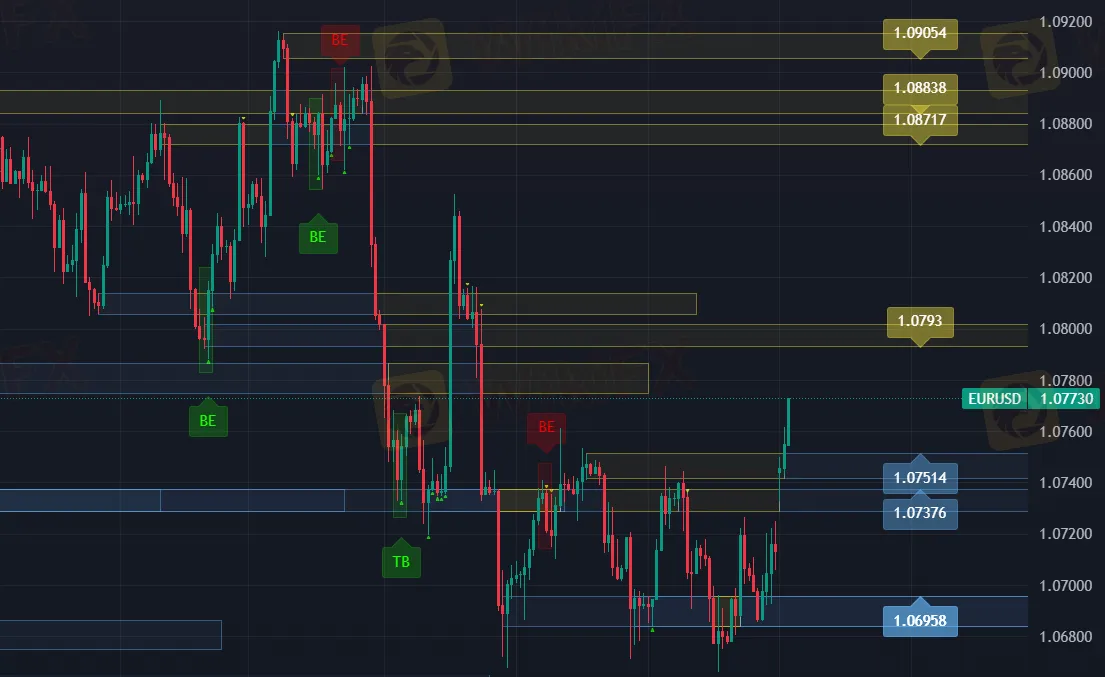简体中文
繁體中文
English
Pусский
日本語
ภาษาไทย
Tiếng Việt
Bahasa Indonesia
Español
हिन्दी
Filippiiniläinen
Français
Deutsch
Português
Türkçe
한국어
العربية
Europe Analysis: EUR/USD, GBP/USD, EUR/GBP
Abstract:The ECB's consumer expectations survey shows mixed economic signals with slight improvements in unemployment expectations but unchanged growth forecasts. The euro faces pressure from a strong USD, while the GBP shows resilience, contributing to the strength of GBP/USD and the decline of EUR/GBP.

EUR/USD 4H Chart

GBP/USD 4H Chart

EUR/GBP 4H Chart
Europe Analysis: EUR/USD, GBP/USD, EUR/GBP
Key Support Levels:
EUR/USD:1.06842
GBP/USD:1.26029
EUR/GBP:0.84158
Key Resistance Levels:
EUR/USD:1.07515
GBP/USD:1.27033
EUR/GBP:0.8500
Recent data from the European Central Bank's (ECB) consumer expectations survey presents a mixed picture for the Eurozone economy. The 12-month ahead unemployment expectation has slightly improved, while the growth expectation remains unchanged at a modest 0.8%. Additionally, the 3-year ahead inflation expectation has slightly decreased, with uncertainty over inflation expectations falling to its lowest level since February 2022. Despite these mixed signals, the euro is facing significant pressure, on track for its largest monthly decline since January, due to the strength of the US dollar.
In contrast, the British pound is showing resilience, heading for its first weekly gain in a month. This gain is supported by improving economic data and market sentiment, contributing to the strength of the GBP against both the USD and the EUR.
Consolidated Impact on EUR/USD, GBP/USD, and EUR/GBP
Overall Sentiment:
EUR/USD:Bearish, driven by mixed economic data from the Eurozone and strong USD performance.
GBP/USD:Neutral to bullish, supported by improving UK economic data.
EUR/GBP:Bearish for EUR, supported by stronger GBP performance.
Key Influences:
EUR/USD:
Improved Eurozone labor market expectations provide limited support.
Unchanged growth expectations and slightly lower long-term inflation expectations.
Significant monthly decline for the euro due to robust USD strength and mixed economic signals.
GBP/USD:
Sterling gains supported by improving UK economic data and market sentiment.
Potential for further GBP strength if UK economic data continues to improve.
EUR/GBP:
Euro weakness against GBP due to mixed Eurozone economic data.
Stronger GBP performance driving EUR/GBP lower.
Potential Movement:
EUR/USD:Likely to remain under pressure with potential downside movement, contingent on further economic data and USD strength.
GBP/USD:Potential upside movement if UK economic data continues to improve.
EUR/GBP:Likely to trend lower with stronger GBP performance against a weaker EUR.
Important Economic Calendar Events for the Eurozone
Eurozone CPI (YoY) (June)– June 30, 2024: A key measure of inflation.
Eurozone Unemployment Rate (May)– June 30, 2024: Indicator of labor market health.
Germany Manufacturing PMI (June)– July 1, 2024: Reflects manufacturing sector activity.
Eurozone Services PMI (June)– July 3, 2024: Indicates health of the services sector.
Germany Industrial Production (MoM) (May)– July 5, 2024: Measures industrial output.
Eurozone Retail Sales (MoM) (May)– July 5, 2024: Indicator of consumer spending trends.
Eurozone Sentix Investor Confidence (July)– July 8, 2024: Measures investor confidence and economic outlook.
UK GDP (MoM) (May)– July 10, 2024: Measure of monthly economic growth.
UK Manufacturing Production (MoM) (May)– July 10, 2024: Reflects manufacturing output.
UK CPI (YoY) (June)– July 17, 2024: A key measure of inflation.
UK Unemployment Rate (May)– July 18, 2024: Indicator of labor market health.
UK Retail Sales (MoM) (June)– July 20, 2024: Measures consumer spending trends.
Important Economic Calendar Events for the UK
Disclaimer:
The views in this article only represent the author's personal views, and do not constitute investment advice on this platform. This platform does not guarantee the accuracy, completeness and timeliness of the information in the article, and will not be liable for any loss caused by the use of or reliance on the information in the article.
Read more

KVB Market Analysis | 27 August: AUD/USD Holds Below Seven-Month High Amid Divergent Central Bank Policies
The Australian Dollar (AUD) traded sideways against the US Dollar (USD) on Tuesday, staying just below the seven-month high of 0.6798 reached on Monday. The downside for the AUD/USD pair is expected to be limited due to differing policy outlooks between the Reserve Bank of Australia (RBA) and the US Federal Reserve. The RBA Minutes indicated that a rate cut is unlikely soon, and Governor Michele Bullock affirmed the central bank's readiness to raise rates again if necessary to combat inflation.

KVB Market Analysis | 26 August: Bitcoin (BTC) Breaks Out Above $60,000, Faces Resistance at $72,000
Bitcoin traded above $60,000 on Friday, gaining over 4% this week but staying within a $57,000 to $62,000 range for the past 15 days. On-chain data reveals mixed signals, with institutions accumulating while some large holders are selling. Inflows into US spot Bitcoin ETFs and potential volatility from ongoing Mt.Gox fund movements could impact Bitcoin's price in the coming days.

KVB Market Analysis | 23 August: JPY Gains Ground Against USD as BoJ Signals Possible Rate Hike
JPY strengthened against the USD, pushing USD/JPY near 145.00, driven by strong inflation data and BoJ rate hike expectations. Japan's strong Q2 GDP growth added support. However, USD gains may be limited by expectations of a Fed rate cut in September.

KVB Market Analysis | 22 August: Gold Stays Strong Above $2,500 as Fed Rate Cut Hints Loom
Gold prices remain above $2,500, near record highs, as investors await the Federal Open Market Committee minutes for confirmation of a potential Fed rate cut in September. The Fed's dovish shift, prioritizing employment over inflation, has weakened the US Dollar, boosting gold. A recent revision showing the US created 818,000 fewer jobs than initially reported also strengthens the case for a rate cut.
WikiFX Broker
Latest News
Why Even the Highly Educated Fall Victim to Investment Scams?
Warning Against Globalmarketsbull & Cryptclubmarket
BSP Shuts Down Uno Forex Over Serious AML Violations
ACY Securities Expands Global Footprint with South Africa Acquisition
Tokyo Police Arrest 4 for Unregistered FX Trading Scheme
Rupee gains against Euro
Axi Bids AUD 52M to Acquire Low-Cost Broker SelfWealth, Outbidding Competitor Bell Financial
Crypto Influencer's Body Found Months After Kidnapping
US Regulators Tighten Oversight on Bank Anti-Money Laundering Efforts
Doo Group Expands Its Operations with CySEC License
Currency Calculator


